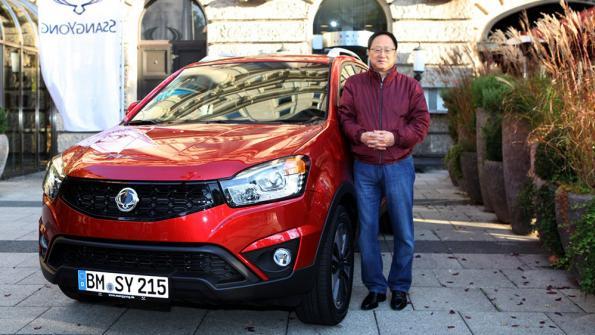Korean Carmaker Ssangyong Looks At US Market During A Dramatic Rebirth

Ssangyong has had a colorful history, to put it lightly. In 1999, the Korean brand entered bankruptcy as its Chinese majority owner, SAIC Motor Company cut Ssangyong loose. Ssangyong made a frenzied attempt to cut its workforce down, and faced one of the worst labor strikes in the Korean auto industry’s history. In retaliation for the cuts, the workers of Ssangyong’s Pyongtaek production plant set fire to the plant, and later occupied it for two months. Riot police, including helicopter support, was called in eventually to clear the plant.
With Ssangyong in shambles, Indian automaker Mahindra & Mahindra bought a 70% stake in the company in 2011 and immediately went to work on labor issues. Since the acquisition, Ssangyong has not suffered any labor downtime and the once rioting workforce now appears to be diligently rebuilding the auto maker, one car at a time.
In 2013, Ssangyong returned and racked up its highest sales, with 145,649 cars sold last year. 81,679 of those sales were made in overseas markets; and a spokesman for Ssangyong confirmed to WardsAuto that the Korean Automaker is looking to expand its product to the U.S. market.
The spokesman confirmed to Wards that a portfolio for North America is being planned with a consultant to help find an approach to the U.S., with the key being a friendly brand name. Aside from the odd-sounding name (to American eyes and ears, at least), Ssangyong looks to leave behind the battle torn image of the past, and exude a quality product.
Ssangyong’s President and CEO Yoo-il Lee has set high goals for 2016, and the U.S. market is a must if they intend to meet them, with a target of 300,000 vehicles by 2016.
But that’s about where the announced plan stops. As mentioned, with last year’s sales hovering just below 150,000, the “Promise 2016” plan intends to double that in a scant two years. With no product ready for U.S. emissions and safety and no dealer network, it’s a lofty goal. US dealers are still wary after Mahindra’s ongoing failure to bring their diesel pick to the US by 2010, and we’ll be impressed if Ssangyong can enter the U.S. market by their 2016 sales goal.

More by Phillip Thomas
Latest Car Reviews
Read moreLatest Product Reviews
Read moreRecent Comments
- Theflyersfan The wheel and tire combo is tragic and the "M Stripe" has to go, but overall, this one is a keeper. Provided the mileage isn't 300,000 and the service records don't read like a horror novel, this could be one of the last (almost) unmodified E34s out there that isn't rotting in a barn. I can see this ad being taken down quickly due to someone taking the chance. Recently had some good finds here. Which means Monday, we'll see a 1999 Honda Civic with falling off body mods from Pep Boys, a rusted fart can, Honda Rot with bad paint, 400,000 miles, and a biohazard interior, all for the unrealistic price of $10,000.
- Theflyersfan Expect a press report about an expansion of VW's Mexican plant any day now. I'm all for worker's rights to get the best (and fair) wages and benefits possible, but didn't VW, and for that matter many of the Asian and European carmaker plants in the south, already have as good of, if not better wages already? This can drive a wedge in those plants and this might be a case of be careful what you wish for.
- Jkross22 When I think about products that I buy that are of the highest quality or are of great value, I have no idea if they are made as a whole or in parts by unionized employees. As a customer, that's really all I care about. When I think about services I receive from unionized and non-unionized employees, it varies from C- to F levels of service. Will unionizing make the cars better or worse?
- Namesakeone I think it's the age old conundrum: Every company (or industry) wants every other one to pay its workers well; well-paid workers make great customers. But nobody wants to pay their own workers well; that would eat into profits. So instead of what Henry Ford (the first) did over a century ago, we will have a lot of companies copying Nike in the 1980s: third-world employees (with a few highly-paid celebrity athlete endorsers) selling overpriced products to upper-middle-class Americans (with a few urban street youths willing to literally kill for that product), until there are no more upper-middle-class Americans left.
- ToolGuy I was challenged by Tim's incisive opinion, but thankfully Jeff's multiple vanilla truisms have set me straight. Or something. 😉


































Comments
Join the conversation
@DM--I am doubtful about Ssangyong entering the US market. As soon as they would enter with a compact 4 door car Nissan would bring the Micra into the market and undercut them. Hyundai and Kia would have a lower price entry as well. Chevy would compete with a lower cost Daewoe as well. The Chinese could eventually enter the US but they might make vehicles for GM, Ford, Chrysler, Toyota, or Nissan before they enter on their own. Many potential franchisees would be wary of doing business with Ssangyong since it is owned by Mahindra. I do see a potential for a midsize diesel truck if it is priced right.
@Jeff S - Without consumer confidence, who cares how low the price is? Would you spend $30,000 for a hard loaded Korean truck that'll likely fall apart and be worth $800 retail in five years when the OEM leaves the US laughing? Of course you would... Why was anybody buying Corollas and Sentras when they could have bought a Daewoo or Daihatu at a huge savings and way more bang for your buck?